HONDA ACCORD SEDAN 2001 Owner's Manual (in English)
Manufacturer: HONDA, Model Year: 2001, Model line: ACCORD SEDAN, Model: HONDA ACCORD SEDAN 2001Pages: 372, PDF Size: 6.1 MB
Page 211 of 372
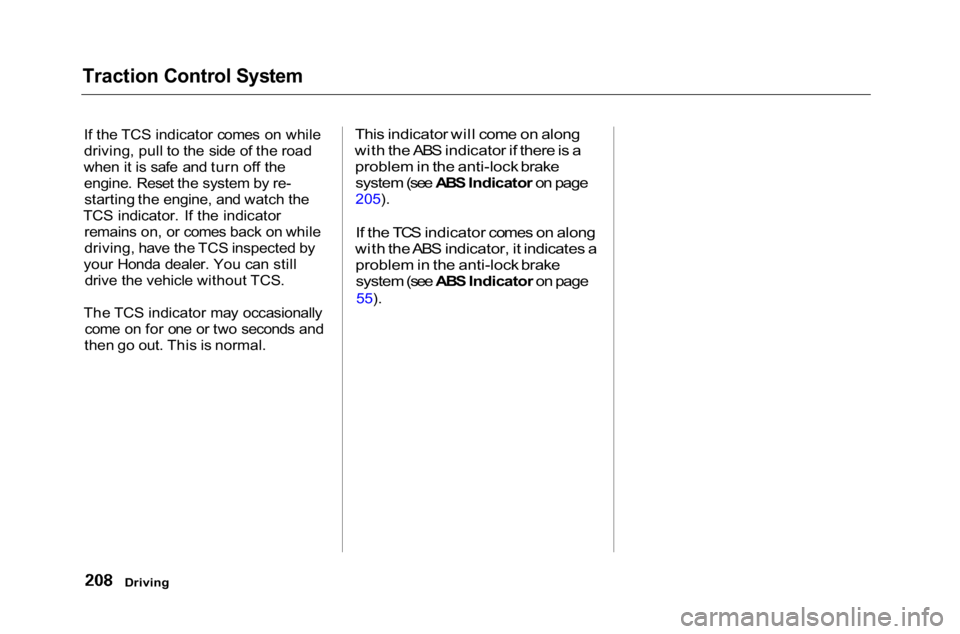
Traction Control System
If the TCS indicator comes on while
driving, pull to the side of the road
when it is safe and turn off the engine. Reset the system by re-starting the engine, and watch the
TCS indicator. If the indicator remains on, or comes back on while
driving, have the TCS inspected by
your Honda dealer. You can still drive the vehicle without TCS.
The TCS indicator may occasionally come on for one or two seconds and
then go out. This is normal.
This indicator will come on along
with the ABS indicator if there is a problem in the anti-lock brakesystem (see ABS Indicator on page
205).
If the TCS indicator comes on along
with the ABS indicator, it indicates a
problem in the anti-lock brakesystem (see ABS Indicator on page
55).
Driving
Page 212 of 372
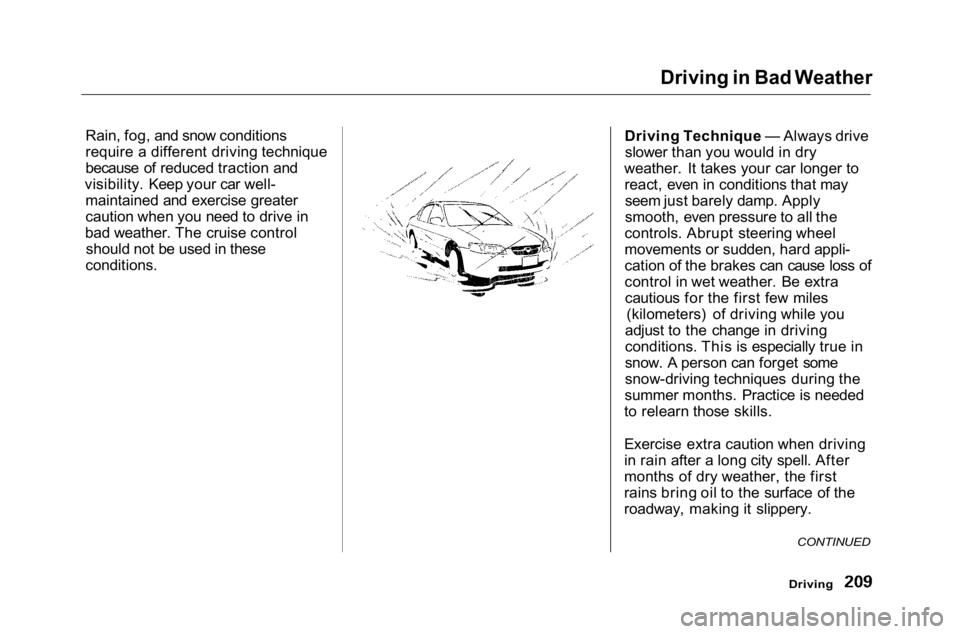
Driving in Bad Weather
Rain, fog, and snow conditions
require a different driving technique
because of reduced traction and
visibility. Keep your car well- maintained and exercise greater
caution when you need to drive in
bad weather. The cruise control should not be used in these
conditions. Driving Technique — Always drive
slower than you would in dry
weather. It takes your car longer to react, even in conditions that mayseem just barely damp. Apply
smooth, even pressure to all the
controls. Abrupt steering wheel
movements or sudden, hard appli-
cation of the brakes can cause loss of
control in wet weather. Be extra cautious for the first few miles (kilometers) of driving while you
adjust to the change in driving
conditions. This is especially true in
snow. A person can forget some
snow-driving techniques during the
summer months. Practice is needed
to relearn those skills.
Exercise extra caution when driving
in rain after a long city spell. After
months of dry weather, the first
rains bring oil to the surface of the
roadway, making it slippery.
Driving
CONTINUED
Page 213 of 372
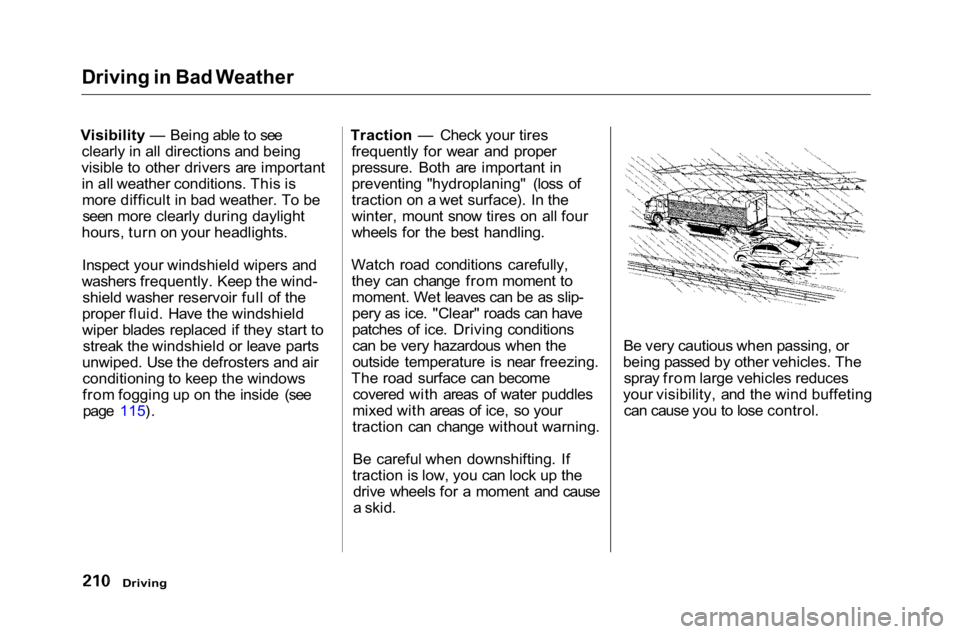
Driving in Bad Weather
Visibility — Being able to see clearly in all directions and being
visible to other drivers are important in all weather conditions. This ismore difficult in bad weather. To beseen more clearly during daylight
hours, turn on your headlights.
Inspect your windshield wipers and
washers frequently. Keep the wind- shield washer reservoir full of the
proper fluid. Have the windshield
wiper blades replaced if they start to streak the windshield or leave parts
unwiped. Use the defrosters and air conditioning to keep the windows
from fogging up on the inside (seepage 115). Traction — Check your tires
frequently for wear and proper
pressure. Both are important in
preventing "hydroplaning" (loss of
traction on a wet surface). In the
winter, mount snow tires on all four
wheels for the best handling.
Watch road conditions carefully, they can change from moment tomoment. Wet leaves can be as slip-
pery as ice. "Clear" roads can have
patches of ice. Driving conditionscan be very hazardous when the
outside temperature is near freezing.
The road surface can become covered with areas of water puddles
mixed with areas of ice, so your
traction can change without warning.
Be careful when downshifting. If
traction is low, you can lock up the drive wheels for a moment and cause
a skid. Be very cautious when passing, or
being passed by other vehicles. The spray from large vehicles reduces
your visibility, and the wind buffeting can cause you to lose control.
Driving
Page 214 of 372
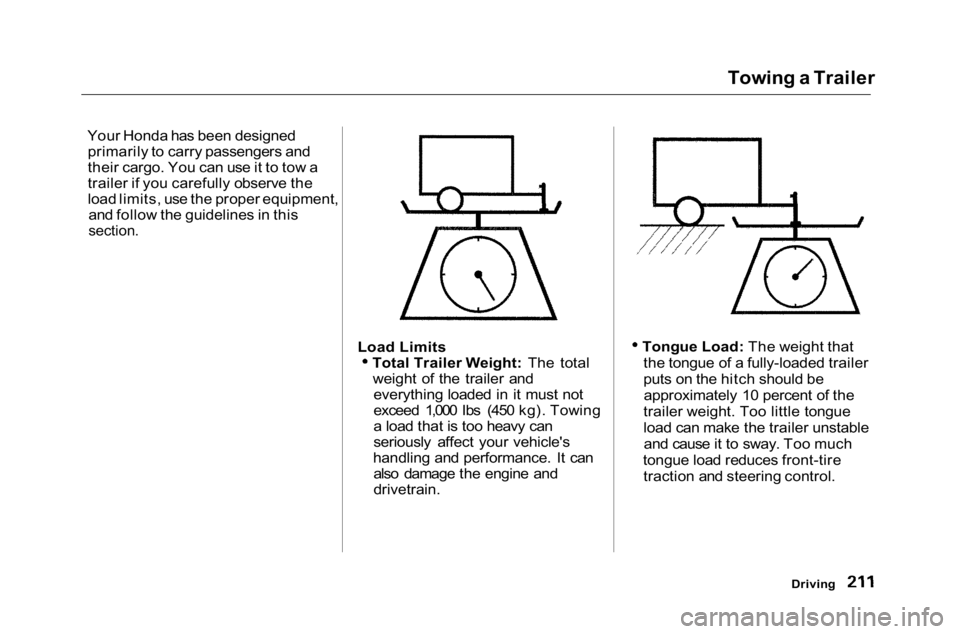
Towing a Trailer
Your Honda has been designed primarily to carry passengers and
their cargo. You can use it to tow a
trailer if you carefully observe the
load limits, use the proper equipment, and follow the guidelines in this
section.
Load Limits Total Trailer Weight: The total
weight of the trailer and everything loaded in it must not
exceed 1,000 Ibs (450 kg). Towing
a load that is too heavy can
seriously affect your vehicle's
handling and performance. It can also damage the engine and
drivetrain. Tongue Load: The weight that
the tongue of a fully-loaded trailer
puts on the hitch should beapproximately 10 percent of the
trailer weight. Too little tongue
load can make the trailer unstable and cause it to sway. Too much
tongue load reduces front-tire traction and steering control.
Driving
Page 215 of 372
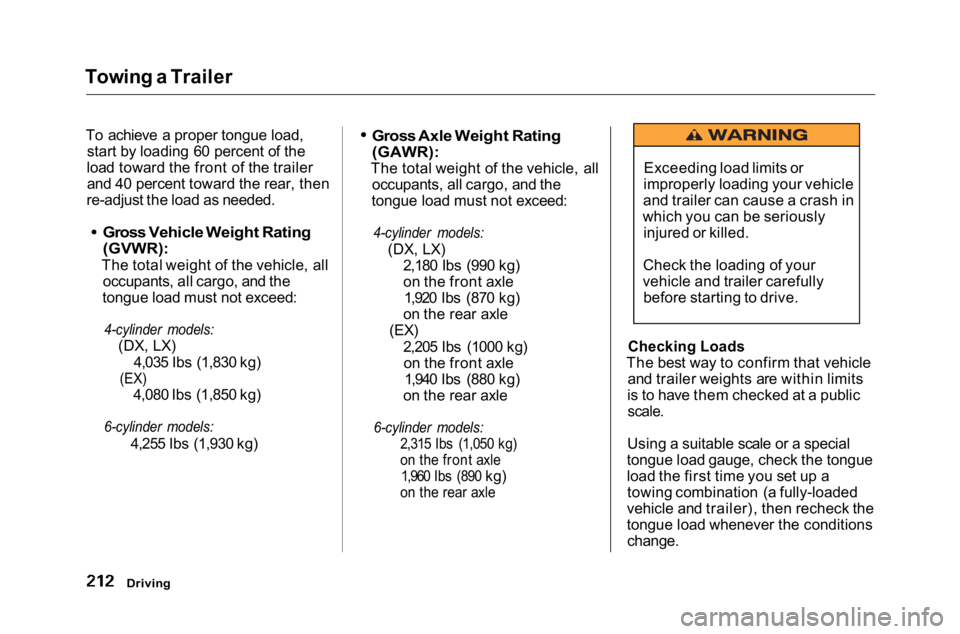
Towing a Trailer
To achieve a proper tongue load, start by loading 60 percent of the
load toward the front of the trailer and 40 percent toward the rear, then
re-adjust the load as needed.
Gross Vehicle Weight Rating
(GVWR):
The total weight of the vehicle, all occupants, all cargo, and the
tongue load must not exceed:
4-cylinder models:
(DX, LX)
4,035 Ibs (1,830 kg)
(EX)
4,080 Ibs (1,850 kg)
6-cylinder models:
4,255 Ibs (1,930 kg)
Gross Axle Weight Rating
(GAWR):
The total weight of the vehicle, all occupants, all cargo, and the
tongue load must not exceed:
4-cylinder models:
(DX, LX) 2,180 Ibs (990 kg)
on the front axle1,920 Ibs (870 kg)
on the rear axle
(EX)
2,205 Ibs (1000 kg)on the front axle 1,940 Ibs (880 kg)
on the rear axle
6-cylinder models: 2,315 Ibs (1,050 kg)
on the front axle1,960 Ibs (890
kg)
on the rear axle
Checking Loads
The best way to confirm that vehicle and trailer weights are within limits
is to have them checked at a public
scale.
Using a suitable scale or a special
tongue load gauge, check the tongue
load the first time you set up a towing combination (a fully-loaded
vehicle and trailer), then recheck the
tongue load whenever the conditions
change.
Driving
Exceeding load limits or
improperly loading your vehicle
and trailer can cause a crash in
which you can be seriously injured or killed.
Check the loading of your
vehicle and trailer carefully before starting to drive.
Page 216 of 372

Towing a Trailer
Towing Equipment and
Accessories Towing can require a variety of equipment, depending on the size of
your trailer, how it will be used, and
how much load you are towing.
Discuss your needs with your trailersales or rental agency, and follow the
guidelines in the rest of this section.
Also make sure that all equipment is properly installed and that it meets
federal, state, province, and local regulations. Hitches
Any hitch used on your vehicle must be properly bolted to the underbody.
Safety Chains
Always use safety chains. Make sure they are secured to both the trailerand hitch, and that they cross under
the tongue so they can catch the
trailer if it becomes unhitched. Leave enough slack to allow the
trailer to turn corners easily, but do
not let the chains drag on the ground.
Trailer Brakes
Honda recommends that any trailer
having a total weight of 1,000 Ibs (450 kg) or more be equipped with
its own electric or surge-type brakes. If you choose electric brakes, be
sure they are electronically actuated.
Do not attempt to tap into your
vehicle's hydraulic system. No matter how successful it may seem,any attempt to attach trailer brakes
to your vehicle's hydraulic system
will lower braking effectiveness and create a potential hazard.
Driving
Page 217 of 372
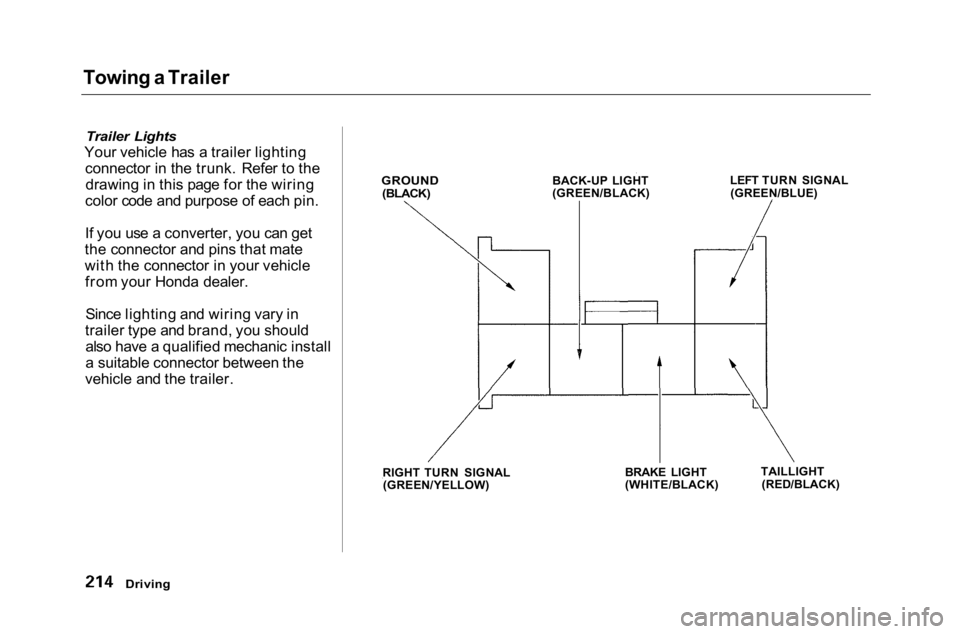
Towing a Trailer
Trailer Lights
Your vehicle has a trailer lighting connector in the trunk. Refer to thedrawing in this page for the wiring
color code and purpose of each pin.
If you use a converter, you can get
the connector and pins that mate
with the connector in your vehicle from your Honda dealer.
Since lighting and wiring vary in
trailer type and brand, you should also have a qualified mechanic install
a suitable connector between the
vehicle and the trailer.
Driving GROUND
(BLACK)
BACK-UP LIGHT
(GREEN/BLACK) LEFT TURN SIGNAL
(GREEN/BLUE)
TAILLIGHT(RED/BLACK)
BRAKE LIGHT
(WHITE/BLACK)
RIGHT TURN SIGNAL
(GREEN/YELLOW)
Page 218 of 372
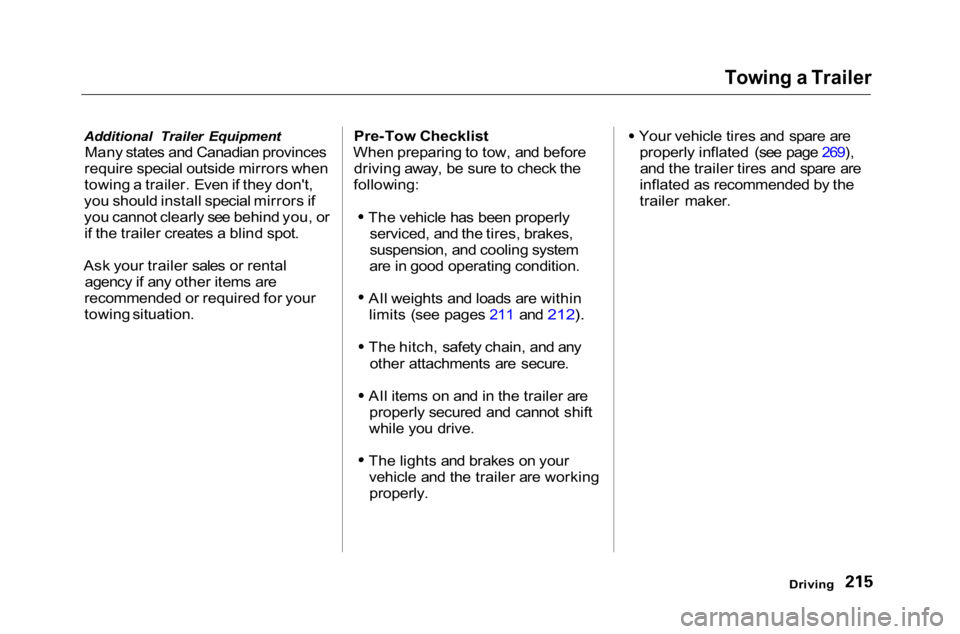
Towing a Trailer
Additional Trailer Equipment Many states and Canadian provinces
require special outside mirrors when
towing a trailer. Even if they don't,
you should install special mirrors if
you cannot clearly see behind you, or if the trailer creates a blind spot.
Ask your trailer sales or rental agency if any other items are
recommended or required for your
towing situation. Pre-Tow Checklist
When preparing to tow, and before driving away, be sure to check the
following: The vehicle has been properly
serviced, and the tires, brakes,
suspension, and cooling system
are in good operating condition. All weights and loads are within
limits (see pages 211 and 212). The hitch, safety chain, and any
other attachments are secure. All items on and in the trailer are
properly secured and cannot shift
while you drive. The lights and brakes on your
vehicle and the trailer are workingproperly. Your vehicle tires and spare are
properly inflated (see page 269),and the trailer tires and spare are
inflated as recommended by the
trailer maker.
Driving
Page 219 of 372

Towing a Trailer
Driving Safely With a Trailer
The added weight, length, and height of a trailer will affect your
vehicle's handling and performance, so driving with a trailer requiressome special driving skills and
techniques.
For your safety and the safety ofothers, take time to practice driving
maneuvers before heading for theopen road, and follow the guidelines
discussed below.
Towing Speeds and Gears
Drive slower than normal in all
driving situations, and obey posted
speed limits for vehicles with trailers.
If you have an automatic
transmission, use D4 position when
towing a trailer on level roads. D3 is
the proper shift lever position to use
when towing a trailer in hilly terrain. (See "Driving on Hills" in the next
column for additional gear
information.)
Making Turns and Braking
Make turns more slowly and wider
than normal. The trailer tracks a smaller arc than your vehicle, and it
can hit or run over something the
vehicle misses. Allow more time and distance for braking. Do not brake or
turn suddenly as this could cause the
trailer to jackknife or turn over.
Driving on Hills
When climbing hills, closely watch your temperature gauge. If it nearsthe red (Hot) mark, turn the airconditioning off, reduce speed and, if
necessary, pull to the side of the
road to let the engine cool.
If the automatic transmission shifts
frequently between 3rd and 4th
gears while going up a hill, shift to
D3.
If you must stop when facing uphill,
use the foot brake or parking brake.
Do not try to hold the vehicle in
place by pressing on the accelerator, as this can cause the automatic
transmission to overheat.
When driving down hills, reduce your speed and shift down to 2nd
gear. Do not "ride" the brakes, andremember it will take longer to slowdown and stop when towing a trailer.
Driving
Page 220 of 372

Towing a Trailer
Handling Crosswinds and Buffeting
Crosswinds and air turbulence
caused by passing trucks can disrupt
your steering and cause trailer swaying. When being passed by a
large vehicle, keep a constant speed and steer straight ahead. Do not try
to make quick steering or braking
corrections.
Backing Up
Always drive slowly and have someone guide you when backing up.Grip the bottom of the steering
wheel; then turn the wheel to the left
to get the trailer to move to the left, and turn the wheel right to move the
trailer to the right.
Parking
Follow all normal precautions when
parking, including firmly setting the
parking brake and putting the
transmission in Park (automatic) or in 1st or Reverse (manual). Also,
place wheel chocks at each of the
trailer's tires.
Driving